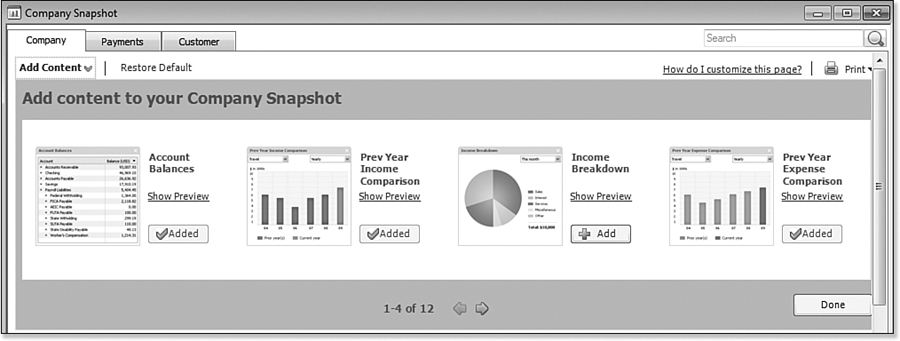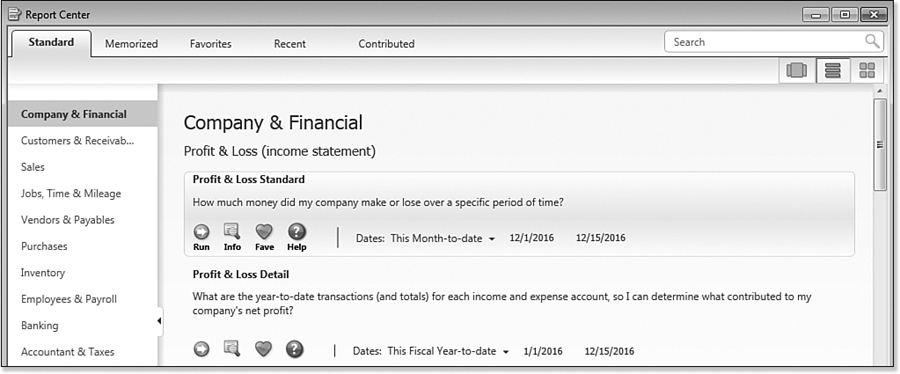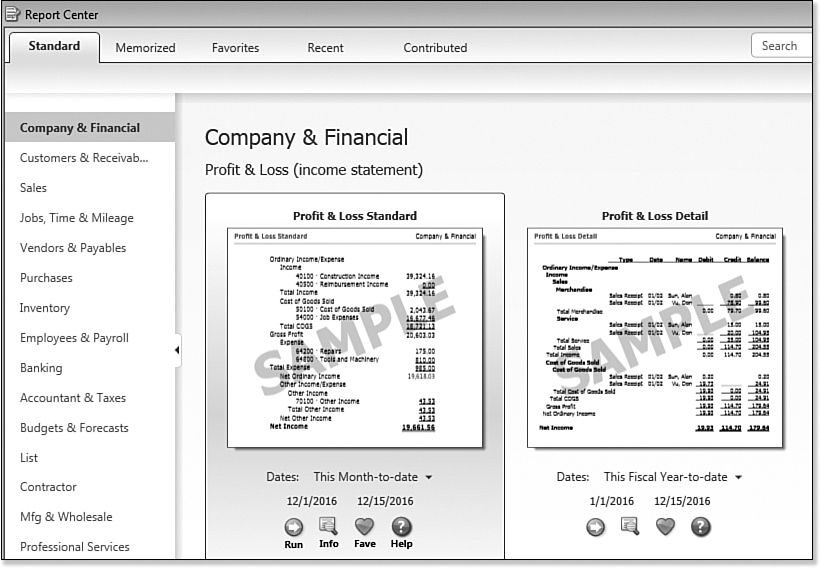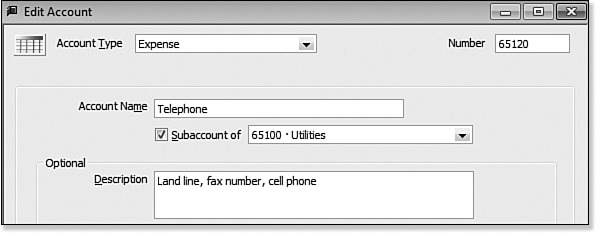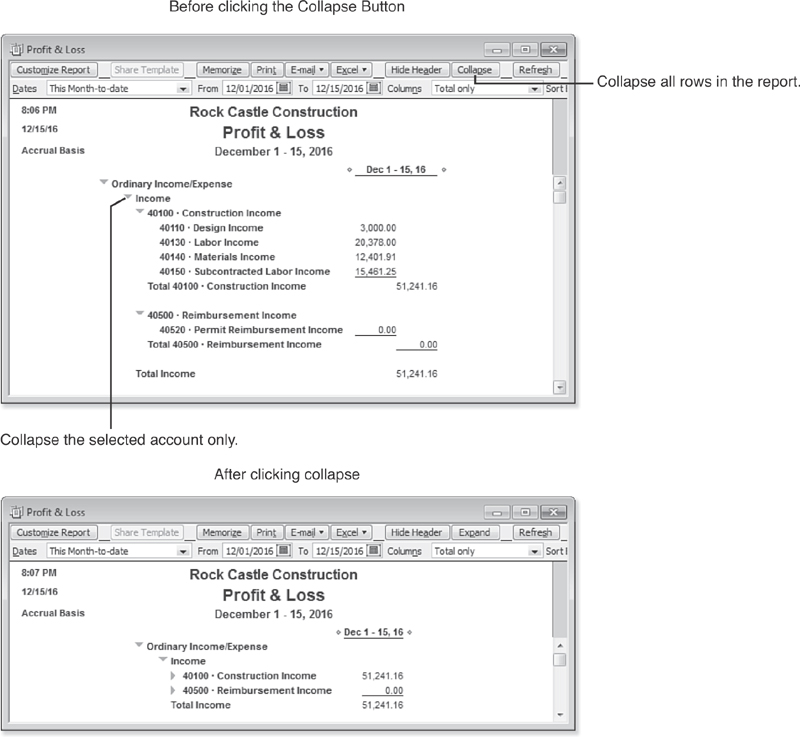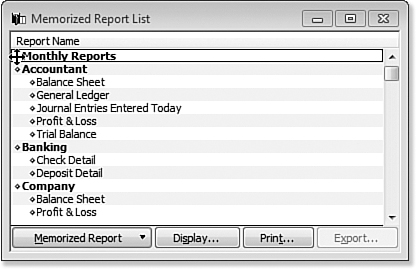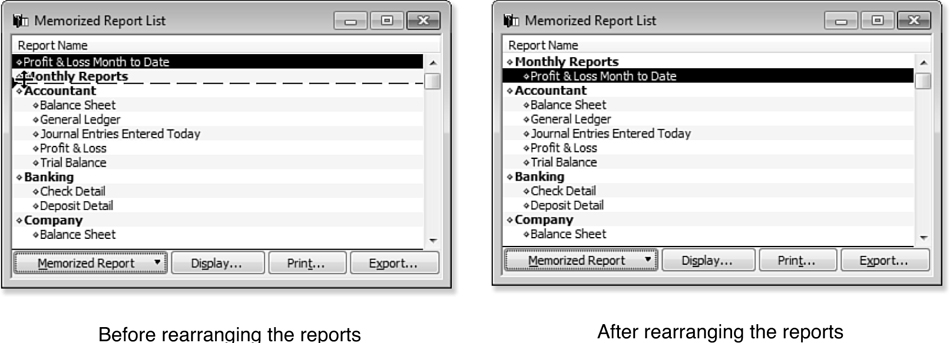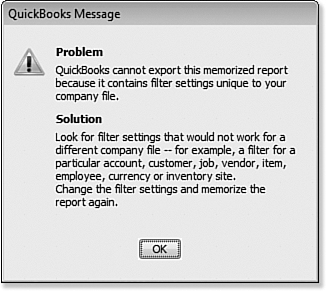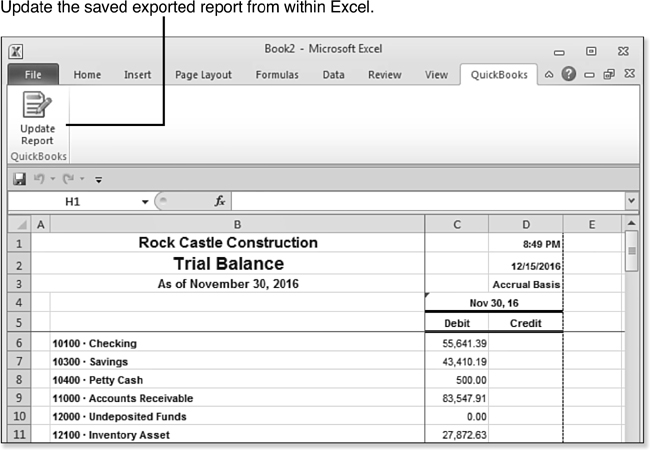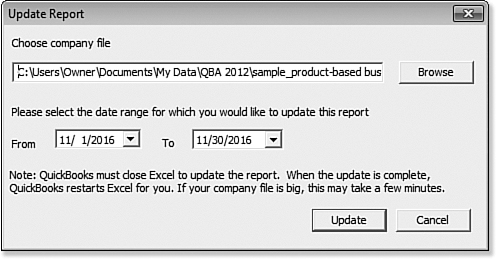14. Reporting in QuickBooks
Using the Company Snapshot
The QuickBooks Company Snapshot offers a real-time view of your company’s critical information. The Company Snapshot provides insight into your business using a variety of analytic and performance indicators ready-made for your use.
The Company Snapshot (see Figure 14.1) is one convenient place to review company information and perform important tasks.
Figure 14.1. The Company Snapshot offers a wealth of useful information.
Customizing the Company Snapshot
QuickBooks offers the ability to customize the snapshot information on both a user and company file-specific basis, which can be helpful in multiuser environments. To customize your Company Snapshot, follow these steps:
1. From the menu bar, select Company, Company Snapshot to view the default graphs and reports.
2. Click Add Content to view and select from additional graphs and reports. See Figure 14.2.
Figure 14.2. Customize the Company Snapshot by adding or removing content.
3. Click the + Add button next to a graph or report to add it to your Company Snapshot.
4. Click Restore Default to remove any graphs or reports you added.
5. Click Done to view your modified Company Snapshot.
6. To rearrange the order or placement of a graph and report, click and hold your left mouse button (a move icon displays), drag the item to a new location, and release the button.
7. Optionally, select one of the following options from the Print menu in the upper-right corner to print your snapshot or prepare it for printing: Print, Print Preview, or Set Orientation.
If your company has created user restrictions in QuickBooks, the user will have access only to activities of the Company Snapshot that he has been provided permission to access. If you do not want the user to see the Income and Expense of the company, you will have to set restrictions for both the Sensitive Accounting Activities and Sensitive Financial Reporting. To modify a user’s security rights, you must be logged into the data file as the Admin user.
After you have set up the security, log in as that user and verify whether the behavior is what you were expecting. For more comprehensive user security settings, consider using QuickBooks Enterprise Solutions 12.0.
Get an immediate view of the bottom line of your business with these reports available on the QuickBooks Company Snapshot:
• Account Balances—By default only Balance Sheet accounts are shown. You can add any other account type to this view by clicking the Select Accounts link.
• Previous Year Income Comparison—View how much money you are making this year compared to previous years for any or all accounts. You can view monthly, quarterly, weekly, or yearly comparisons.
• Income Breakdown—This section shows your company’s largest sources of income.
• Previous Year Expense Comparison—Compare how much money you are spending this year to previous years for any or all accounts. You can view monthly, quarterly, weekly, or yearly comparisons.
• Expense Breakdown—This section shows your company’s biggest expenses.
• Income and Expense Trend Graph—This section of the Company Snapshot shows money going in and out of your business.
• Top Customers by Sales—Easily report on who your top five customers are based on sales for a given period of time.
• Best Selling Items—This section shows you which items and services customers are buying the most during a given period of time. You can view the data by amount or by units
• Customers Who Owe Money—Review those customers who owe your company money. Overdue items are shown in red. To sort any of the columns, click the column header in any of the panes. The Due Date shown is the earliest due date for all invoices or statement charges for that customer.
• Top Vendors by Expense—This section shows who your top five vendors are based on expenses for a given period of time.
• Vendors to Pay—Skip running the aged payables report by adding this section to your Company Snapshot. Amounts shown in red are past due. To sort any of the columns, click the column header. The Due Date shown is the earliest due date that the vendor bills are due. The Amt Due column is the total ending balance for that vendor.
• Reminders—Never forget important tasks. Include these critical reminders on your Company Snapshot. Click the Set Preferences link in the Reminders box to customize what information you want displayed.
Defaulting the Company Snapshot as Home Page
If you wish to have the Company Snapshot display when you first open a company file, follow these steps:
1. Click the Company Snapshot icon on the icon bar to open the Company Snapshot. Alternatively, select Company, Company Snapshot from the menu bar.
2. With the Company Snapshot displayed, select Edit, Preferences from the menu bar and select Desktop View on the left side of the Preferences dialog box.
3. On the My Preferences tab, select the Save Current Desktop option button. See Figure 14.3.
Figure 14.3. The desktop preference settings control what opens automatically when you launch QuickBooks.
4. Uncheck the option to Show Home Page When Opening Company File. When you open your data file, the Company Snapshot will automatically display.
Report Center
Up to this point in the book, you have learned how to get started with QuickBooks and create a variety of transactions. In this chapter you will learn from step-by-step instructions for creating specific reports to assist you with your QuickBooks setup or review.
If you are new to QuickBooks or if you have never reviewed the QuickBooks Report Center, in this section you can find out about the many features available for simplifying your reporting needs in QuickBooks.
The Report Center is available in the following editions of QuickBooks: Pro, Premier, Accountant, and Enterprise.
To open the Report Center, click Reports on the icon bar or, alternatively, select Reports, Report Center from the menu bar. The Report Center displays, as shown in Figure 14.4. Features of the Report Center include:
Figure 14.4. The QuickBooks Report Center in Carousel View.
• Option to view the reports or graphs in Carousel View, List View (see Figure 14.5), or Grid View (see Figure 14.6) by selecting one of the icons on the top right of the Report Center.
Figure 14.5. Optionally view your reports in List View.
Figure 14.6. Use the Grid View to find reports for your business.
• Select a grouping of reports from the Standard tab. Your displayed report groups might differ from those shown in Figure 14.4 depending on the version of QuickBooks you are using.
• In Carousel View, use the scroll bar at the bottom of the displayed report to move through samples of the reports available in the selected report group. Data displayed is sample data.
• Click the Dates drop-down list to select a specific date, or accept the default date. (You can also click the dates to modify.)
• Click the Run icon to display the report details with your company data.
• Click the Fave icon to mark or unmark as favorite. Marking a report as a favorite places it on the Favorites Report Center tab.
• Click the Help icon to open Help information about the specific report.
• Optionally, click the arrow notch on the left of the Carousel view to close the menu report group listing.
The Report Center also includes a new tab in QuickBooks 2012 named Contributed, which displays reports shared by other QuickBooks users. QuickBooks does not share any financial data from your company file. When you share a report, you are only sharing the report structure. If the report is filtered for specific chart of accounts or other unique user-defined data, the report might not be able to be shared.
To share a report from the Memorize Report dialog box (see Figure 14.16) select the Share the Report Template With Others and follow the prompts to give the report a title and brief description.
Reports & Graphs Preferences
QuickBooks makes it easy for you to customize reports globally through the use of the Reporting Preferences. Reporting Preferences come in two types: My Preferences, which are unique to a logged-in user, and Company Preferences, which can be set only by the Admin or External Accountant user and represent global settings for all users.
My Preferences
The My Preference setting for reports is user specific. These preferences are set only for the currently logged-in user. To access user-specific preferences for reports, select Edit, Preferences from the menu bar. In the Preferences dialog box, select Reports & Graphs and click the My Preferences tab.
You can specify the following settings that will be unique for the currently logged-in user (if using QuickBooks in a multi-user mode):
• Prompt Me to Modify Report Options Before Opening a Report—When selected, this option causes QuickBooks to open the Modify Report dialog box each time a report is opened.
• Reports and Graphs—You have a choice, when report details have changed, to request QuickBooks to select one of the following options: Prompt Me to Refresh (this is the default option for a new data file), Refresh Automatically, or Don’t Refresh. (I usually select the Refresh Automatically option.) However, if the report is lengthy and you have multiple users entering data, you might want to review a report, make changes, and not have QuickBooks refresh at the time the change is made.
• Graphs Only—This option offers settings for drawing in 2D (which is faster) or using patterns.
Company Preferences
Different from the My Preference setting for Reports and Graphs, the Company Preferences can only be set by the Admin or External Accountant user and are global settings for all users.
To access Company Preferences for reports, log in as the Admin or External Accountant user in single-user mode and select Edit, Preferences from the menu bar. In the Preferences dialog box, select Reports & Graphs, click the Company Preferences tab, and set global defaults (for all users) for the following items:
• Summary Report Basis—You can choose Accrual (default) or Cash Basis. For business owners, I suggest that you discuss this option with your accountant.
• Aging Reports—You can choose to age from the due date (default) or age from the transaction date. This setting determines the aged status of your accounts receivable or accounts payable reports.
• Format—Click the Format button to set the following options globally for all reports:
• Show Header Information—I recommend leaving each of these choices selected and not modifying them in this window.
• Show Footer Information—Here you can enter an additional footer line, such as “Confidential Information” or the like.
• Page Layout—Standard (the default), left, right, or center justified.
• Fonts—You can set this on the Fonts & Numbers tab. Use this to set fonts for all text or specific text lines. As you select the text line on the left, QuickBooks will display the current font choice and size for that text.
• Show Negative Numbers—Format choices include normal –300.00; in parentheses (300.00) or with a trailing minus 300.00–. Optionally, you can select to have these numbers print in red.
• Show All Numbers—Use this setting to divide all numbers by 1,000, to not show zeros, or to show numbers without the cents. These options are most often used by accounting professionals when providing a statement to a bank and so on.
You can display accounts by Name Only (the default), Description Only, or Name and Description. These are fields you completed in the Add New Account or Edit Account dialog boxes, as shown in Figure 14.7.
Figure 14.7. Optionally, include a description in addition to the account name.
• Reports—Show accounts by:
• Name Only—Shows account name and account number, as shown in Figure 14.8 (if the Use Account Numbers preference is enabled).
Figure 14.8. Resulting report when the Name Only report preference is selected in addition to having the account numbering preference enabled.
• Description Only—Shows only the information typed in the Description field (shown in Figure 14.9).
Figure 14.9. Resulting report when the Description Only report preference is selected.
• Name and Description—Shows account number, account name, and description, as shown in Figure 14.10.
Figure 14.10. Resulting report when the Name and Description report preference is selected in addition to account numbering preference enabled.
• Statement of Cash Flows—Click the Classify Cash button to open the Classify Cash dialog box. From there you specify your Balance Sheet accounts as Operating, Investing, or Financing cash flow types.
Modifying Reports
QuickBooks makes gathering information from your data quick and easy. Though many reports are already created and organized for your use, you might on occasion want to modify an existing report.
This section briefly discusses the options available when you want to modify a report.
Modifying Options Available on the Report Window
A few of the options to modify a report are available directly on any active report dialog box. The options include:
• Hide Header—Removes the header, or report title section, from the report. Click Show Header when you want it to appear.
• Collapse—You can also collapse the information, as shown in Figure 14.11. When you click the Collapse button, QuickBooks removes the subaccount detail from view only. This allows you to toggle a report between summary and detail views on the fly.
Figure 14.11. Click the Collapse button on a report to roll up the subaccounts into the main account.
• Columns—For certain reports, you can easily control how the data is subtotaled or grouped and add additional columns or sub-columns.
• Sort By—Use this to group the detail into useful ways for your review. I use this frequently, especially when looking at reports with many lines of detail. Your sort by options will vary based on the type of report you have displayed.
Other options on the active report window are also discussed in this chapter.
New for QuickBooks 2012: Each line on a report can be collapsed or expanded manually. Click the gray arrow in front of any row report detail. This feature was included in one of the product updates. For more information about product updates, see “Installing a QuickBooks Maintenance Release,” p. 560.
Customizing Reports
Click the Customize Report button at the top left of the open report dialog box. The options for modifying reports vary by report type. Some reports offer the following choices (others might not offer the same report modification choices):
• Display tab—This tab opens automatically when you choose to customize an existing report. The choices you have on the Display tab will vary depending on the report being modified. These choices might include:
• Report Date Range—Choose from the QuickBooks predefined date ranges, or set a custom date range for your report.
• Report Basis—You can choose Accrual or Cash. This option is not available on all reports. This allows you to override the default preference you might have set in Reports & Graphs preferences.
• Columns—This setting is useful for selecting what information you want to see and whether you want it sorted or totaled by a specific field on the resulting report.
• Advanced Button—This button is often overlooked, but its settings enable users to display active, all, or non-zero rows as well as the desired reporting calendar.
• Revert Button—Undo of any changes made to the settings.
• Filters tab—Use these options to filter for specific accounts, names, or transaction types as well as many other fields that can be filtered on.
• Header/Footer tab—Use this tab to modify the report title and the appearance of the information that displays on the report. You can set this information globally for all users; see the section, “Company Preferences” earlier in this chapter.
• Fonts & Numbers tab—Use this tab to specify fonts for specific line text as well as how numbers appear in your reports. You can set this information globally for all users; see the section, “Company Preferences” earlier in this chapter.
Filtering a report is easy and convenient to do when you want only specific information from a longer report.
If you do filter, you might want to modify your report title so it identifies what has been filtered. For example, if you are filtering a report to show employee advances detail, you might want to modify the report title on the Header/Footer tab to Employee Advances Detail so those who read the report will know it is pulling out specific information.
Report Groups
Users often overlook report groups, which allow you to run two or more reports in QuickBooks at once. This feature can streamline your reporting process. This section highlights how to create, use, and manage report groups.
If a client were prone to making mistakes when entering data, I would teach him how the data should look, give him his own report group, and request that he review these reports before my appointment.
Creating Report Groups
For accountants, this feature can save you precious time each period you work with your client’s data. You can create a group of reports that you review each time you work with the client’s file.
To create a report group, follow these steps:
1. From the menu bar, select Reports, Memorized Reports, Memorized Report List. The Memorized Report List dialog box displays (showing predefined groups and associated reports).
2. Click the Memorized Report drop-down list at the bottom of the list and select New Group.
3. In the New Memorized Report Group dialog box, provide a name for the group. Click OK to return to the Memorized Report List. QuickBooks places your new group alphabetically in the existing list of report groups.
4. Click the X in the upper right to close the Memorized Report List.
If you work in the file with Multiuser access enabled, select File, Switch to Single User Access before attempting to move a group of reports on the list.
If you are going to create several reports that are included as part of this report group, you should move this newly created report group to the top of the list. As you memorize reports for this group, QuickBooks defaults the report group in the Memorize Report dialog box to the first Report Group on the list.
When you are done memorizing the reports to this report group (see the next section), you can move the group list item back alphabetically within the rest of the memorized reports or groups.
To move a report group up or down the list, place your cursor over the diamond shape in front of the report group name. Drag the item up or down. Figure 14.12 shows the new Monthly Reports group being moved to the top of the list.
Figure 14.12. Create a report group so you can easily display or print multiple reports at one time.
Using Report Groups
The primary purpose of report groups is to simplify displaying or printing multiple reports at one time.
To display a group of reports, follow these steps:
1. From the menu bar, select Reports, Process Multiple Reports. The Process Multiple Reports dialog box displays.
2. From the Select Memorized Reports From drop-down list, select the specific report group you want to create, as shown in Figure 14.13.
Figure 14.13. The Process Multiple Reports dialog box enables you to choose what group you want to conveniently display or print.
3. Remove the checkmark for any report you do not want to process in the group. Figure 14.14 shows a sample of selected reports.
Figure 14.14. The Banking report group has been selected, and those reports memorized with this group are shown.
4. In the From and To columns, change the date as needed. Be aware that these changes are not permanent. The next time you create the report group, the original date range stored with the report appears. If you want the new dates to appear next time, you need to memorize the report again and select the Replace button to replace the previously stored report with the new date range.
5. Click Display to view the reports on your computer screen or click Print to send the selected reports to your printer.
Your report group will now generate the multiple reports for you to view or print. I often create a report group for my clients named either Monthly or Quarterly Reports. In this group, I put certain reports I want them to review before my appointment. This method helps them help me in keeping their QuickBooks data reporting organized.
When memorizing a report you will add to a report group, be aware of the date range selected. If you want to generate a report for the current month-to-date, you would select This Month-to-Date as the default date range. When the report is generated, QuickBooks will use data from the current month-to-date.
If you select a specific range of dates on a memorized report, QuickBooks considers those dates custom and will always generate the report with those specific dates.
Managing Report Groups
To manage a report group, follow these steps:
1. From the menu bar, select Reports, Memorized Reports, Memorized Report List. The Memorized Report List dialog box displays (showing predefined groups and associated reports).
2. Click the Memorized Report button at the bottom of the list to choose the following memorized report list options:
• Edit Memorized Report—Edit the name of an existing report list item or which group it is associated with (you do not edit the date ranges or filters from this dialog box).
• New Group—Used to create an association of multiple reports, discussed in the previous section.
• Delete a Memorized Report—Helpful in managing the list and changes over the years.
• Print the List—Do this if needed to manage what reports are useful.
• Re-sort the List—Not often needed with this list, but if used, your list will return to its original order before any custom changes to the organization of the list items.
• Import or Export a Template—Create and then use reports for multiple client data files.
![]() For more information, see “Exporting and Importing Report Templates,” p. 489.
For more information, see “Exporting and Importing Report Templates,” p. 489.
3. To rearrange your reports, place your cursor on the diamond in front of the report name, and click and drag down and to the right, as shown in Figure 14.15. Release the mouse button when the report is in the desired position.
Figure 14.15. Click and drag the diamond in front of any report or group to rearrange the list manually.
From the memorized report list, you can also export your reports to Excel without first displaying them in QuickBooks. Use these report groups to streamline your data reviews. You can use the Memorize feature for many of the special reports discussed in this book and place them in a report group for easy and frequent access.
Memorized Reports
After you have created a report group, you can use the memorize feature for the reports you want in that group. Placing your memorized reports in a group is optional, but using groups helps keep your memorized reports organized.
To memorize a report, click the Memorize button at the top of an open report, as shown in Figure 14.16. QuickBooks requires you to give the report a name and optionally lets you assign it to a report group or share it with others (optional). (You must first create the report group so it displays in the drop-down list in the Memorize Report dialog box.)
Figure 14.16. Click Memorize on any displayed report, give the report a name, and (optionally) assign it to a report group or share the template with others.
If you choose not to assign a report group, your memorized reports are listed individually at the top of the Memorized Report List, as shown previously in Figure 14.15.
Exporting and Importing Report Templates
QuickBooks offers the option to export and import report templates. This feature is useful for accountants who want to save time by having several clients use the same report template.
Only the format and filter settings are stored with report templates. If you create a report template and then have several clients use it, when the client imports it, the desired report is generated with the current client’s data, not the data it was created with.
You can export and import a single report or a group of reports only from the Memorized Report List. So before you attempt to export a report, be sure to memorize it first.
Exporting a Report or Report Group Template
To export a report or report group template, follow these steps:
1. From the menu bar, select Reports, Memorized Reports, Memorized Report List.
2. From the Memorized Report drop-down list, select Export Template.
3. The Specify File Name dialog box displays, enabling you to select a location to store the template (.QBR extension).
4. Attach the stored report template or report group to an email, or copy it to a removable storage device such as a USB drive to share with other QuickBooks data files.
Certain restrictions exist when creating a template for export. For example, if you filter for a specific chart of account or customer name that might not be present in every customer’s file, QuickBooks will provide the message shown in Figure 14.17 warning that this report cannot be exported.
Figure 14.17. If your report has specific filters, you might not be able to export and share it with multiple data files.
Importing a Report or Report Group Template
To import a report or report group template, follow these steps:
1. From the menu bar, select Reports, Memorized Reports. The Memorized Reports List dialog box displays.
2. Select Import Template from the Memorized Reports List drop-down list.
3. The Specify File Name dialog box displays, enabling you to select the stored location of the .QBR template.
4. Select the appropriate .QBR report or report group template.
5. Click Open. The Memorize Report dialog box displays for you to assign a name for the report and optionally assign it to a group.
6. Click OK to add the report to your memorized report list.
Did you know that an abundance of reports are already created for you to import into your or your client’s data file?
Both business owners and accountants will find these reports useful and unique to what you already have in QuickBooks.
Go to http://community.intuit.com/quickbooks. On the right, select Library from the More Resources section. Select the Reports For QuickBooks 2012 And Above link in Reports section. From the Search drop-down menu, select All Reports or select a specific category.
Exporting Reports to a .CSV File or to Excel
You might have occasions where you want to export your reports to Excel to manipulate them in some more extensive manner than is available within QuickBooks.
To export a report to either .CSV or Excel format, follow these steps:
1. From any report window, click the Excel button at the top of the report.
2. Click Create a New Worksheet. (If you are updating a previously exported report select Update Existing Worksheet and follow the prompts to browse to the file location.)
3. The Send Report to Excel dialog box displays with these options:
• Create New Worksheet, in a new workbook or in an existing workbook
• Update an existing worksheet
• Create a comma separated values (.csv) file
I generally try to discourage exporting to Excel and do my best with a client to find the appropriate report in QuickBooks, simply because any changes you make to your report in Excel do not “flow” back into your QuickBooks data file. However, new with the release of QuickBooks 2012, you can link exported reports, so changes made in your QuickBooks data will update your spreadsheet.
4. Optionally click the Advanced tab of the Export Report dialog box for options to preserve QuickBooks formatting, enabling certain Excel features, and printing options. Try different configurations of these settings to see what best suits your needs. See Figure 14.18. Changes made to the Advanced tab settings affect future exported reports. Click OK.
Figure 14.18. Advanced Excel includes options for formatting the exported QuickBooks report.
5. Click Export to create the exported report, as shown in Figure 14.19.
Figure 14.19. Easily convert any QuickBooks report or list to an Excel or .csv format.
6. Select the QuickBooks Export Tips worksheet tab for additional useful hints in working with exported reports. The Advanced button includes an option to Turn Off creating the QuickBooks Export Tips worksheet.
Remember, however, that changes made in Excel to the exported report details are “static”—their information is fixed in time. Changes made to the Excel report do not transfer back into QuickBooks.
However, you can send changes in QuickBooks out to your Excel report by selecting Update an Existing Worksheet. Another method for updating a saved Excel exported report is to select the QuickBooks tab in Excel’s ribbon interface and select Update Report. See Figure 14.20.
Figure 14.20. New for QuickBooks 2012, update the saved file from the QuickBooks tab in Excel.
Emailing Reports
Did you know that you can email reports from within QuickBooks? This can be a convenient way to get information to your customers, vendors, and even accountant. You can email reports as two types of attachments: individual Adobe PDF files or Excel workbooks. You must have an Internet connection on the computer that is used to send the report.
If you want to set Outlook as your default email, select Edit, Preferences, Send Forms from the menu bar. Select the My Preferences tab where you can set the default email application to be QuickBooks or Outlook. You can also choose from other email providers.
To email a report, follow these steps:
1. From the open report, click Email and choose whether to Send Report as Excel or to Send Report as PDF (see Figure 14.21).
Figure 14.21. Reports sent as PDF or Excel attachments can use your own Outlook account to send.
2. If a security message displays, indicating that sending information over Internet email is not secure, click OK to continue or click Cancel.
3. If you are sending the report through Outlook, add your email address and any additional comments to the email. Click Send when you’re done. You are returned to your QuickBooks data file, and the email is stored in your Outlook sent folder.
If you are not using Outlook for email, click Send Now and QuickBooks transmits the email for you.
If you do not use Outlook for your email, QuickBooks continues to send the email through QuickBooks Business Solutions, which has been available for years. Figure 14.22 shows how the email is created within QuickBooks when Outlook is not your email program.
Figure 14.22. Send a report as an attachment through QuickBooks (when you don’t use Outlook).


